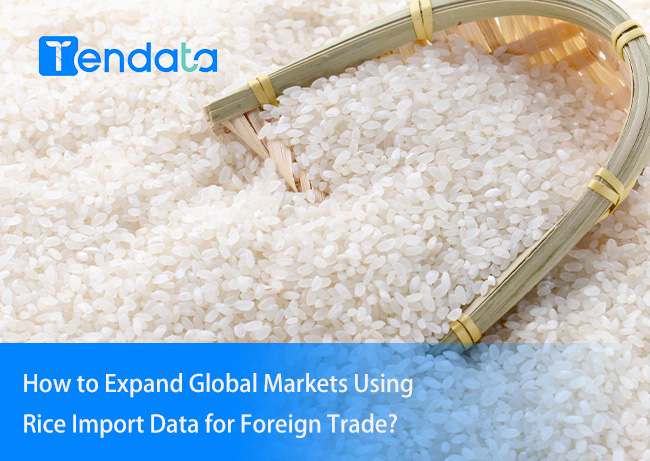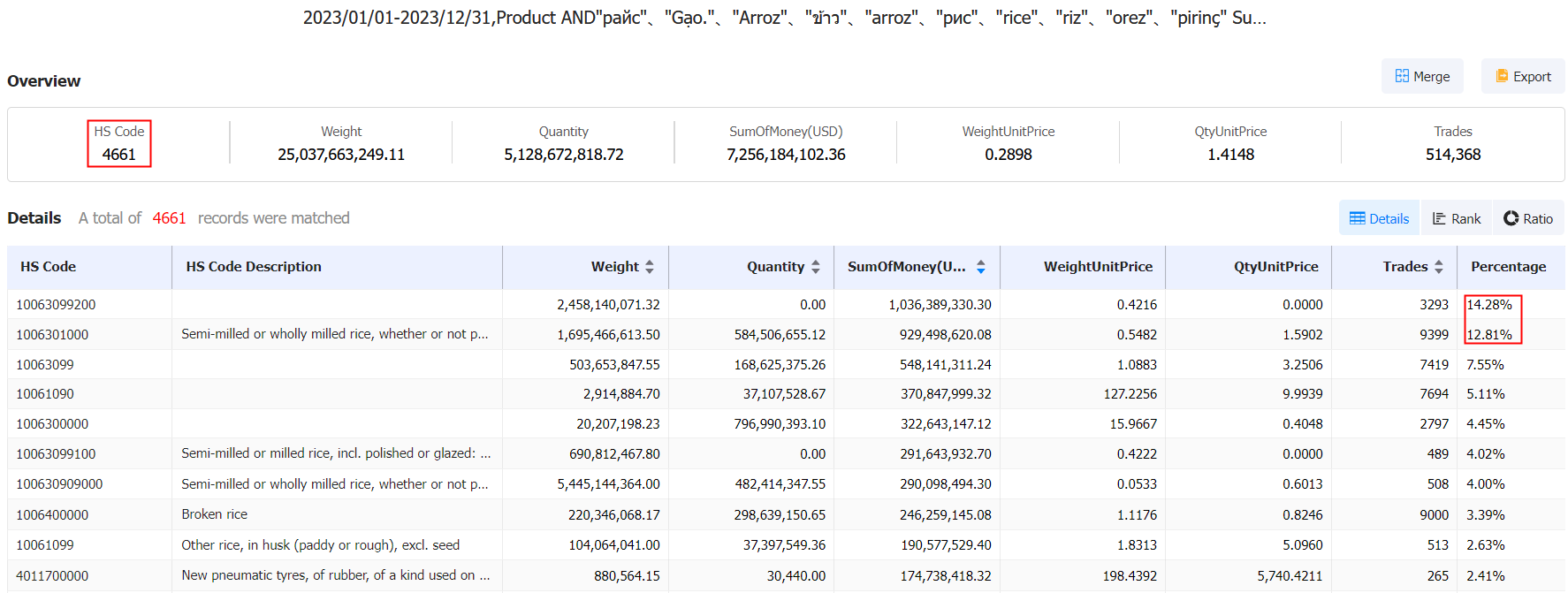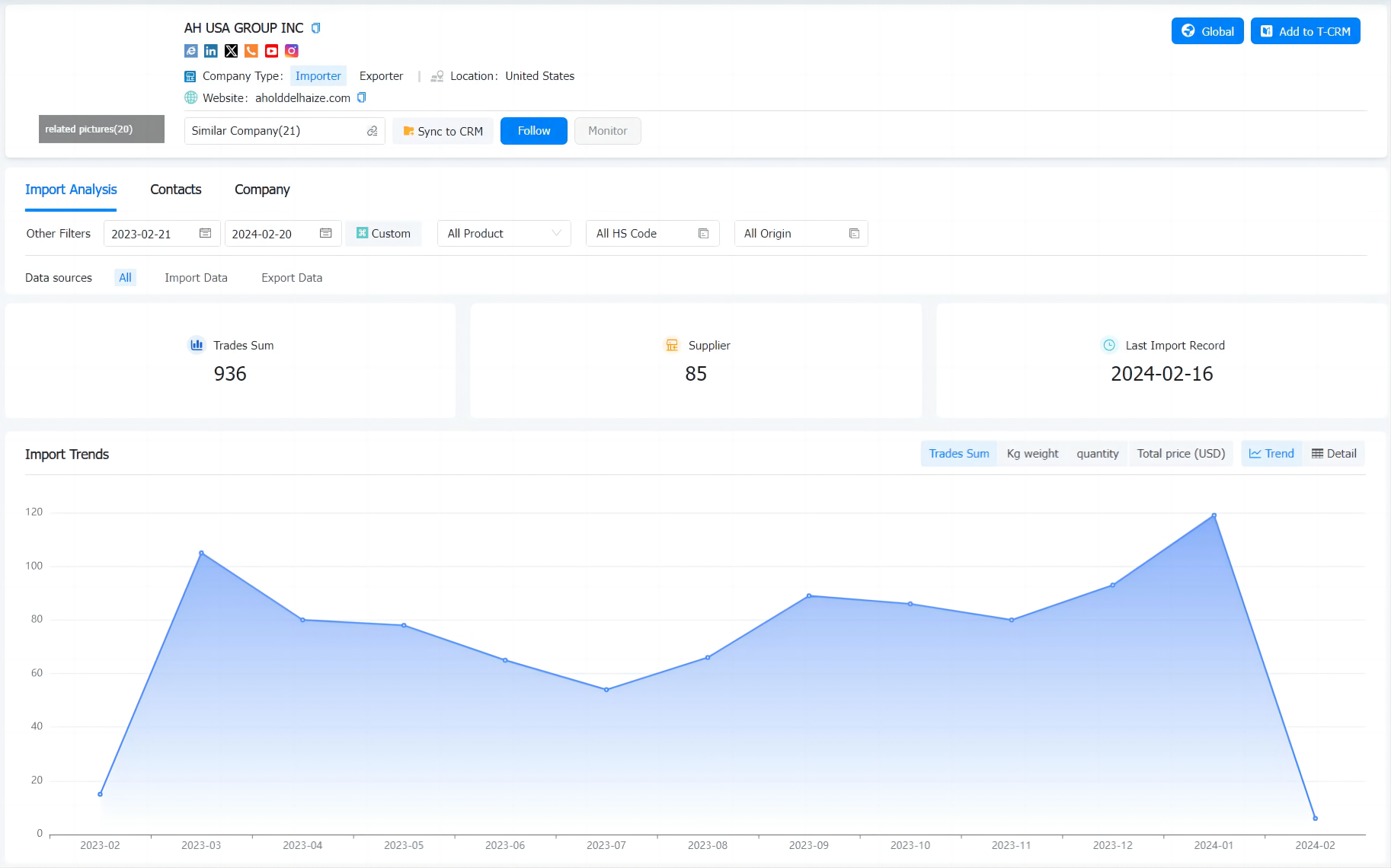 Export News
Export News
 20-02-2024
20-02-2024
As a food readily available in grocery stores, rice is considered a convenient product for consumers. Rice is a staple in soups, particularly as a side dish for fish and chicken, used to fill vegetables, and is also an ingredient in making bread, desserts, and breakfast porridge.
The 4-digit Harmonized System (HS) code prefix for rice is 1006.
The global import volume of different types of rice is:
1. Fully or partially milled rice (comprising 79% of the global rice import volume)
2. Broken rice (9%)
3. Husked or brown rice (7.4%)
4. Rice in the husk, paddy rice, or rice considered as rough (5.1%)
By comparing rice import data and examining the changes in consumer demand for imported rice in various countries, we can identify the most attractive opportunities for selling rice and related products and services in the international market.

How to Expand Global Markets Using Rice Import Data for Foreign Trade?
Step 1: Understand the Global Rice Market Overview Based on Rice Import Data
In 2022, global demand for imported rice resulted in sales reaching $31
billion.
Since 2018, the total import value of rice from all buying countries has averaged a 15.2% increase, with the global rice procurement cost being $26.9 billion at that time.
In 2021, global rice import volume increased by 7.1% year-on-year, with sales reaching $29 billion.
The top 5 countries for rice imports are Mainland China, the United States, the Philippines, Saudi Arabia, and Iran. These top 5 rice buyers collectively account for about one-fourth (24.7%) of the global demand for imported rice.
From a continental perspective, in 2022, Asian countries consumed the highest-value imported rice, with a purchase amount of $14.1 billion, accounting for 45.6% of the global total. Africa is the second-largest importer, accounting for 24.2%, while an additional 15.3% of the global rice import volume is delivered to European buyers.
North America (7.5%), Latin America (5.6%) (excluding Mexico but including the Caribbean region), and Oceania countries led by Australia (1.7%) received smaller proportions from importers.
Step 2: Study the Fluctuations in Global Rice Market Demand Based on Rice Import Data
Through the rice import data provided by Tendata, we can explore new market
opportunities and trends, such as which countries and regions are experiencing
an increase in the demand for rice imports and which countries and regions have
a steady growth in rice import volume.
By leveraging this rice import data, we can determine which rice products have a market, and which countries have the potential for rice product exports. This information helps in expanding into new markets and increasing business reach. Exporters can also more precisely select potential customers, identifying countries and regions with larger import volumes or emerging import markets.
Here are the top 15 countries by the highest import value of rice in 2022:
1. China: $2.6 billion (8.5% of the total rice import value)
2. United States: $1.4 billion (4.5%)
3. Philippines: $1.3 billion (4.1%)
4. Saudi Arabia: $1.2 billion (3.9%)
5. Iran: $1.16 billion (3.7%)
6. Iraq: $1.11 billion (3.6%)
7. Côte d'Ivoire (Ivory Coast): $810 million (2.6%)
8. United Arab Emirates: $722.6 million (2.3%)
9. Japan: $670.4 million (2.2%)
10. France: $655.9 million (2.1%)
11. Benin: $635.3 million (2%)
12. Malaysia: $609.3 million (2%)
13. United Kingdom: $603.2 million (1.9%)
14. Senegal: $557.2 million (1.8%)
15. Belgium: $554.2 million (1.8%)
In 2022, the top 15 countries purchased 47.1% of the total imported rice. Import regions worldwide still have demand for imported rice.
Among these countries, the fastest-growing rice markets since 2021 are the United Arab Emirates (82.1% growth), Iran (58.8% growth), Iraq (39.6% growth), and the United States (38.2% growth).
Benin is the only buyer country where rice purchases have declined, with a decrease of -1.3%.
Step 3: Select Target Customers Using Rice Import Data
By using Tendata, we can access rice import data from various countries and
regions, including information on which types of rice have larger import volumes
and which specifications of rice are more popular. This information provides a
basis for understanding customer needs and preferences, supporting the
development of subsequent product development and marketing strategies.

Step 4: Develop Marketing Strategies Based on Rice Import Data
Utilizing the rice import data provided by Tendata, we can formulate more
precise marketing strategies based on an understanding of customer needs and
preferences. For example, different styles and specifications of rice can be
introduced for different countries and regions, or personalized services and
solutions can be provided based on customer purchasing habits and
preferences.
Step 5: Strengthen Customer Relationship Management
By using the rice import data provided by Tendata, we can obtain detailed
information on customer purchase history and collaboration, including purchase
volume, purchase cycles, and supplier change information. This rice import data
helps to comprehensively understand customer needs and collaboration situations,
providing more comprehensive support and assurance for future
collaborations.

In conclusion, to develop "rice" customers using Tendata's foreign trade expansion software, it is essential to work meticulously in areas such as data screening, understanding customer needs, formulating marketing strategies, customer relationship management, and market expansion. Additionally, it is necessary to adjust and optimize development strategies promptly based on actual situations and market changes.
Uncovering Foreign Trade Opportunities – Mainly Through Foreign Trade Data
Currently, the government has officially rolled out policies to support the development of the big data industry. In this era, customs data has become an indispensable part of the international trade ecosystem. The new approach to facilitating transactions in the Information Age involves constantly uncovering new business opportunities from customs data using big data analysis methods.
Shanghai Tendata's Foreign Trade Portal covers detailed customs data from 91 countries, (>>> Click to use data online for free) statistical data from 27 EU countries, millions of accurate and genuine buyer information, and detailed information on completed customer transactions. The system offers a one-click generation of 17 types of market data analysis reports, assisting management in making informed decisions effortlessly.
Tendata's foreign trade big data can help foreign trade companies in identifying, marketing to, and managing customers, as well as fulfilling orders with a complete set of products and solutions. In the future, Tendata will continue to explore products to cater to more scenarios within the export industry.
In summary, Tendata is a big data company and a pioneer in the Chinese trade industry, helping foreign trade businesses in customer development, market analysis, trade facilitation, and data output.

Category
Leave Message for Demo Request or Questions


 T-info
T-info T-discovery
T-discovery

 My
Tendata
My
Tendata Market Analysis
Market Analysis Customer
Development
Customer
Development Competitor
Monitoring
Competitor
Monitoring Customer Relationship
Customer Relationship





































































































































